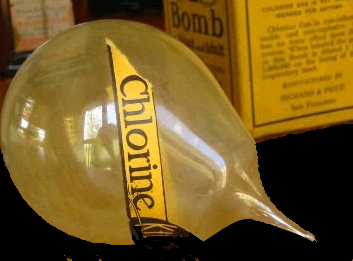False advertising- Listerine
When we have a cold we often go to the doctor expecting to come away with medicines that will cure us at an instant. We are all too often disappointed when the doctor prescribes rest and warmth. In a scientifically literate society we would be aware of how a virus functions and how antibiotics are useless against such efficient and simple organisms. Here lies the problem, advertising companies exploit a scientifically illiterate society. We are even oblivious to the simple action of bacteria and fungi in our daily lives associating them only with disease and death not thinking of the many foods and medicines they provide.
• What are the claims made for Listerine in each advertisement?
• How does each advertisement support its claims?
• Is each advertisement targeted at a specific group? Do they use emotional tactics? Explain.
• Are the advertisement convincing? Why
• Argue against the claims made in each advertisement.
If you think a chlorine bomb sounds more like something from the battlefield than the medicine cabinet, then you’d be right about the origins of this 1920s remedy. The product, and a brief trend among physicians for treating colds with chlorine, arose from experiments made by the US Chemical Warfare Service after the First World War.
Treatments were ineffective as immediate treatments but patients got better in a few days. This was enough for people to claim success. A cold getting better after three days? Who would have thought it possible?
In 1925 the University of Minnesota demonstrated via a controlled experiment that patients with colds recovered in the same amount of time with or without chlorine, but by then the idea had entered the commercial world and sufferers were being exhorted to ‘Bomb the first sneeze’ with Kilacold.
The adverts were quite insensitive and outrageous claiming ‘Chlorine bombs are safe and sane,’ the advertising asserted. ‘Thousands of doctors declare the late war worthwhile because it gave the world the chlorine treatment.’
Chlorine is a poisonous gas that turns the skin, green, yelow and black and when inhaled destroys lung tissue causing fluid buildup in the lungs drowning the victim in their own body fluids. It was used during WW1 by the Germans with devastating consequences.


The Kilacold chlorine bomb was a teardrop-shaped glass ampoule containing 0.35g of chlorine gas. The patient had to break the end off to allow the gas to permeate the air of a closed room. According to the advertising their cold would disappear within an hour. The treatment was also promoted for flu, whooping cough, croup, bronchitis and for diphtheria carriers, but was not recommended for people with asthma. The bombs cost 29c each at Walgreens in 1925.
How would you conduct a trial to see how effective chlorine bomb was against colds?
Specify what the dependent and independent variables would be.